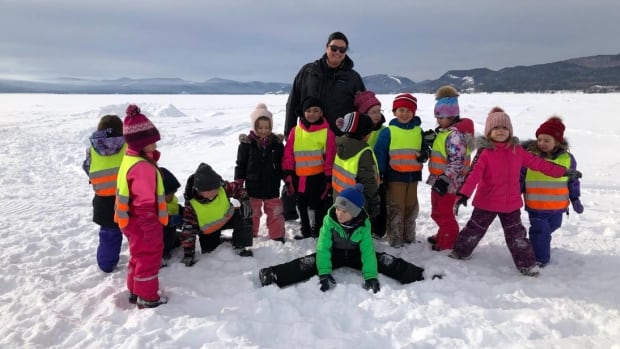On a warm, clear day in February, Brenda Germain picks up a large hand drill and asks her students to gather around.
Drill in hand, she shows the children how to cut through the thick ice covering Chaleur Bay, on Quebec’s Gaspé coast.
“Base concumi — the ice is this thick,” her colleague and aunt, Joyce Germain, tells the students as they kneel over the hole, hoping to catch some smelt, or kaqpesaw.
The class outing is being held entirely in Mi’kmaw — a language that Brenda Germain says she “didn’t speak a word” of, just a decade earlier.
“I spent 35 years of my life thinking, ‘ah man, I missed the boat,'” she said.
But her life — and her teaching career — took a sharp turn in 2018, when she switched roles in the classroom. Brenda Germain enrolled as a student in the Mi’kmaw adult immersion program, offered by the Elawsimgewei Gina’muo’guom Adult Education Centre in Listuguj, Que.
In addition to the classes, “just from coming out on the land with [Miss] Joyce every day has taught me” the language, she said.
“It’s super important to tell people: no matter what age you are, you can start somewhere.”
Benefits of outdoor education
She is now not only fluent in Mi’kmaw but also at the forefront of language revitalization in Listuguj. Brenda Germain was instrumental in building the Forest Kindergarten program, which takes the classroom outside, centred around Mi’kmaw immersion.
She first pitched the idea to the school’s principal after seeing a short clip about outdoor learning in Germany and the Netherlands. The answer came the very next day: yes.
A base camp was built in the forest near the community. After their outings, the kindergarten students gather there at the end of the day, to reflect on what they’ve learned.
“It’s embedded in who we are and you can’t separate the two — outdoors and Mi’kmaw way,” Brenda Germain said.
Miss Joyce, in addition to being Brenda’s aunt, has also been a Mi’kmaw teacher for 23 years. She was involved with the development of Mi’kmaw learning at Alaqsitew Gitpu School from Day 1.
“My passion was to teach the language and it’s always been a part of me — and it’s part of our community,” she said.

With the help of two teaching assistants, Joyce and Brenda Germain also do “mini-lessons” in small groups, exploring wildlife and nature they find around them.
“Instead of having one teacher in front of the class and having 25 kids learn the same thing at the same time from the same person, they’re able to discover the outdoors,” said Brenda Germain.
“Ta’s’gl Uggwatl geggungl? how many legs do they have? Talamugsit? — what colour is it?”
Before long, the teachers realized how easy it would be to fit the school curriculum into outdoor learning, by bringing back what they learned outdoors to classroom discussions.
“That’s where they gain all their vocabulary and understanding of the language,” said Joyce Germain.
Before introducing outdoor education, Brenda Germain said they used to spend more time correcting behaviour. Now, both teachers feel the children are more willing to learn because they’re enjoying themselves.
“I have a lot of students that have learning disabilities or different disabilities — from ADHD, autism — and they perform a lot better outdoors than they do indoors,” said Joyce Germain.

Passing over the baton
Joyce Germain said she admires how quickly her niece Brenda caught on to the Mi’kmaw language, and is thankful she’ll be able to take over when she retires in a few years.
“She has very, very much potential for our community and is a good asset,” said Joyce Germain. “I think she’ll do really well with the program.”
Brenda Germain said she will miss having Joyce’s knowledge around her daily, but she thinks she has learned enough teaching side-by-side with her aunt “to hold the fort.”
“She’s really good at kicking me out and saying: ‘go, you can do it, Brenda,'” she laughed.
“It should be that way. She should feel so comfortable to retire, but we need to hold her as a knowledge keeper and hold her as an expert,” said Brenda Germain.

When Joyce leaves, Brenda Germain and her colleagues will continue to teach a new generation of students to count, name animals and speak about their feelings in Mi’kmaw.
A big step in itself, Brenda Germain recognizes.
“I never thought in a million years that sitting down to do homework with my children, it would be all in Mi’kmaw language.”
Breakaway8:14Kindergarten class from Listuguj heads outdoors to learn Mi’kmaw
Two teachers from the Mi’gmaq community of Listuguj took it upon themselves to design a classroom where kindergarten students could learn Mi’kmaw – with much of the learning happening outdoors. The CBC’s Nation Isaac stopped by the class and also took part in an ice fishing expedition to find out more.


